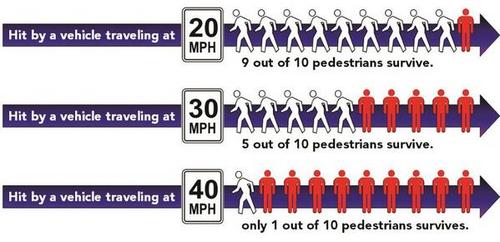Life is too important to give speed cameras a loophole
Vehicle speed kills. Even a small increase in speed can mean the difference between life and death for a pedestrian. But laws limiting speed camera enforcement make them less effective at making our streets safer.
At 20 miles per hour, when a motorist hits a pedestrian, the pedestrian has a 90 percent chance of surviving the crash. At 30 miles per hour, the chance of survival has dropped to 50%. At 40 miles per hour, the pedestrian has a 90% chance of dying.

Graphic from PEDS Atlanta.
In Maryland, speed camera tickets can only be issued to motorists going at least 12 miles per hour over the speed limit. That severely blunts the effectiveness of the cameras for saving lives.
In my neighborhood on the east side of Greenbelt, the city has installed speed cameras on 2 neighborhood streets near Eleanor Roosevelt High School. One of the cameras is near a well-used, mid-block crosswalk that many students use. The speed limit in these areas is 25 mph, which means that drivers have to be going 37 mph before they get a ticket.
A collision at 25 mph would be less than 50% likely to kill a pedestrian. But a collision at 37 mph would bring an almost 90% chance of death.
On Monday, I witnessed a driver flying down the street, well above the speed limit. But I wondered if he was even going fast enough to get a ticket from the speed camera. Even on a quiet neighborhood street, drivers in Greenbelt can go fast enough to cause almost certain death for pedestrians without fearing a speed camera ticket.
That’s the real effect of Maryland’s speed camera restrictions: It allows drivers some leeway, but puts vulnerable road users at risk.
But it’s actually worse than that, because the speed limit itself is actually determined using the arcane “85th percentile speed” in many places, including by the Maryland State Highway Administration. While that’s not a factor on my street, it is on other streets nearby, and throughout the state.
Essentially, highway engineers look at how fast people drive. And they set the speed limit for what 85% of motorists drive. So, for example, on a street, if 85% of drivers go 40 mph, the speed limit is set at 40, even if circumstances (like the presence of a school) suggest that it should be lower.
And remember, that our highways are already designed for speed. The concept of driver forgiveness means that engineers try to design broad curves, wide lanes, and open spaces so that if a driver makes a mistake, it won’t be fatal (for the driver). But these design choices also give subtle psychological hints to drivers to go faster.
And then they set the speed limits based on how fast drivers actually go. And then we limit automated enforcement to 12 mph over that. The result, of course, is that when a pedestrian is struck, the chance of survival is far too low. Especially in the suburbs.
Maryland could help by lowering the threshold for automated speed enforcement. In the District, there is no threshold for speed cameras. A driver can be ticketed for going just 1 mile per hour over the limit.
